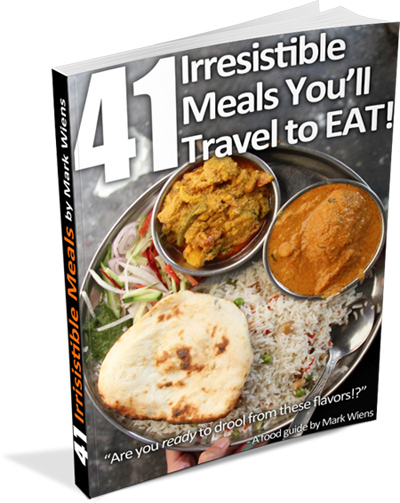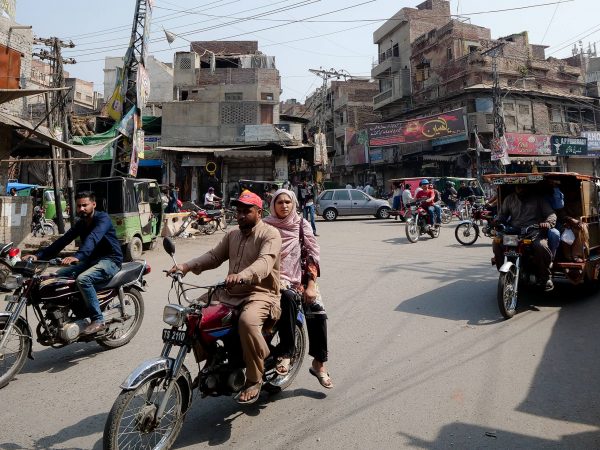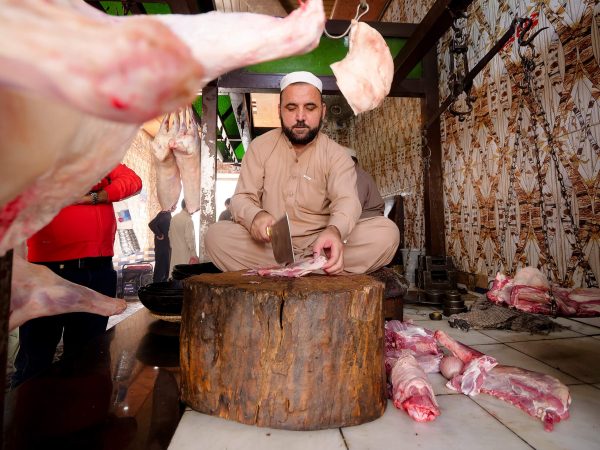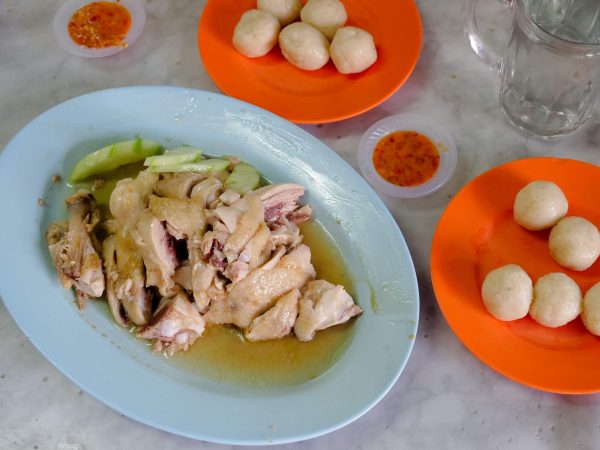

In most of the world, mention the word “tea”, and it’s immediately recognized as a beverage.
In Myanmar however, mention tea, and it can be associated with either a drink, or a food.
Along with the ever-present dish of mohinga, lahpet thoke (လက်ဖက်သုတ်), or Myanmar (Burmese) tea leaf salad, is one of the most well known and popular dishes throughout the country.
Among the mixture in the dish, tea leaves, which are preserved by pickling and are slightly fermented, are the most fundamental ingredient.
In Myanmar, you don’t want to miss eating tea!

History of tea
Tea is a hugely popular beverage around the world, but the origins of the plant are traced back to the area of northern Myanmar and southern China, including the Yunnan and Sichuan provinces, bordering Myanmar.
Tea has been a major part of the culture in Myanmar for a very long time – I’m not sure exactly how long, but I do know tea is highly important throughout Myanmar.
Myanmar is in fact one of the few, if only countries in the world, that has a tradition of both eating and drinking tea.

Where to eat lahpet thoke (လက်ဖက်သုတ်)?
I’m not fully sure about other parts of Myanmar, but in Yangon, if you’re looking to eat some lahpet thoke (လက်ဖက်သုတ် Burmese tea salad), there are two different places to find it.
Number one is at a sit down restaurant. It’s a very typical Myanmar dish, and can usually be found at nearly all Burmese restaurants – places like Feel Restaurant (more on this place soon).
Number two is at street food tea stalls. The indicator that you need to look for is a bunch of plastic tupperware looking tubs at the stall (like in the photo above, right side table), which is an indicator that they serve a variety of Burmese salads.
The salads served at places like this, are a little more complex, and take a few more ingredients, than the salads like tofu thoke (coming soon) that you can order from the carrying pole mobile street food carts.

I didn’t get to take photos of the ingredients when she was making my plate of lahpet thoke (လက်ဖက်သုတ်) as I was making a video, but I did snap some shots of the next salad I ordered: gyin thoke (ဂျင်းသုပ် ginger salad).
The ingredients for both salads, as well as the preparation method, seemed to be quite similar, but instead of pickled tea leaves, pickled shredded ginger was used.
Get exclusive updates
Enter your email and I’ll send you the best travel food content.

For salads in Myanmar, the ingredients are usually all tossed into a metal mixing bowl, and then hand mixed.
On my last trip to Myanmar a few years ago, I don’t remember any vendors using plastic gloves to mix the salad, but this trip seemed like almost all the street food vendors I ate at, used a plastic throw-away glove for mixing the salads.
I think that’s a good step in improving sanitary conditions of street food eating in Myanmar.
But anyway, after she tossed in all the ingredients for my salads, and mixed them up thoroughly, she then plated them on small metal saucers.
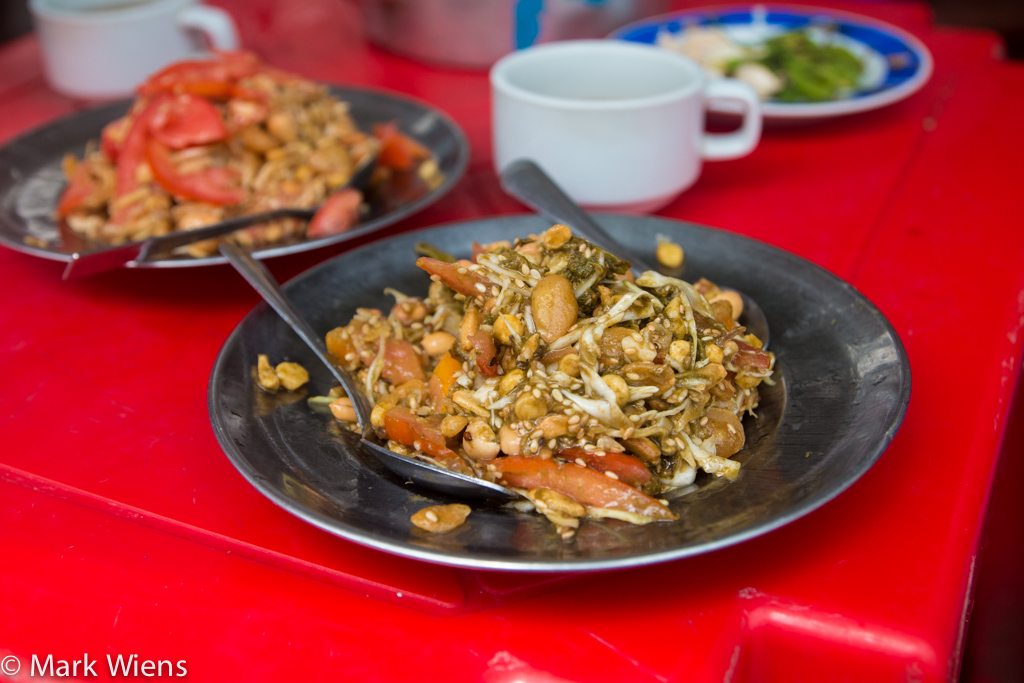
Lahpet thoke (လက်ဖက်သုတ်)
The main ingredients in most plates of lahpet thoke (လက်ဖက်သုတ်) include pickled tea leaves, slices of tomato, shaved cabbage, fried peas, roasted peanuts, sesame seeds, ginger, and garlic.
The dressing is oil based, usually peanut oil, combined with a bit of fish sauce and lime juice.
On the streets, I noticed they also added some powder, which looked like Knorr flavoring, which was surely a combination of flavoring and MSG. At restaurants perhaps they don’t use this type of flavor enhancer, which is surely not part of the traditional recipe.

Gyin thoke (ဂျင်းသုပ်)
Along with Burmese tea leaf salad, being a lover of ginger, ginger salad has always been one of my favorites as well.
Just like the tea leaves, the ginger is pickled and preserved. A similar mixture of ingredients go into gyin thoke (ဂျင်းသုပ်), and also a similar dressing coats the salad.
The ginger has a beautifully mild taste–it’s still very much ginger–but it’s sweet and spicy, and not too harsh to handle. I’m a huge fan of ginger salad.

Salads that I’ve eaten in Myanmar are not normally overly spicy from the start, but the good news is, there’s always a small plate of chilies and garlic on your table.
I like to eat a few bites of salad and then supplement with a bite of chili, which not only adds a bit of heat, but a nice pungency. The garlic, which you can eat the skin of, also tastes fantastic, and is mild in comparison to bigger cloves.

Back to the laphet thoke…
Honestly, if I didn’t know it was pickled green tea leaves, and I tasted it, I probably wouldn’t guess it was tea leaves.
The leaves have a slight bitter herb flavor, but when they are pickled they have more of a sour pickled taste. Combined with the dressing and other ingredients they really blend into everything else, to create a magnificent mixture.
But once you know it’s tea, you can sort of the taste the flavor of tea at the back of your mouth.

I love the contrast of textures in a plate of lahpet thoke (လက်ဖက်သုတ်), the fresh crispness of the cabbage and tomato, the soft pickled tea leaves, and the hard crunch from the peanuts and fried peas.

Monsoon season in Myanmar
I visited Yangon in the middle of July, right in the heart of rainy season, or the monsoon.
It rained a lot.
It would rain for 30 minutes, then stop for 15 minutes, then rain again for 30 minutes, and stop again for 15 minutes in a nearly perfect cycle.
Whenever I had a 15 minute break from the rain, Ying and I would run to the next street food stall, in an attempt to beat the next downpour.
We sat down at this particular tea stall and salad shop when it was almost sunny. 15 minutes later the clouds seemed to come from nowhere, and all of a sudden, the rain started pouring.

At first things were fine, but after a few more minutes of intense rainfall, our toy plastic table and chairs became an island in a rushing flash flood.
Ok, it wasn’t that bad… but when you’re sitting on a miniature plastic stool that’s 20 cm off the ground and there’s an extra 10 cm of water on the road, it’s time to stand up.
Luckily, our table didn’t float away!

Conclusion
Salads are a major part of the food in Myanmar, and there’s no salad that’s more popular and widely beloved than lahpet thoke (လက်ဖက်သုတ်) or pickled tea leaf salad.
Lahpet thoke (လက်ဖက်သုတ်) makes a wonderful accompaniment to a full meal, or is a wonderful light snack to enjoy while sitting on the side of the street drinking cups of hot tea.
Whatever setting you choose, make sure you don’t miss eating tea leaf salad when you’re in Yangon, Myanmar.
Salad stalls in Yangon
You’ll find identical tea and salad stalls, like the one pictured above, scattered everywhere throughout Yangon. But that being said, not all tea stalls have it.
Look for a tea stall that has a table set up with a variety of ingredients in plastic tubs, and then you can be quite certain they will have lahpet thoke (လက်ဖက်သုတ်) waiting for you.
This particular stall pictured, is near Sule Pagoda on the corner of Maha Bundala and 19th street.
Get exclusive updates
Enter your email and I'll send you the best travel food content.
